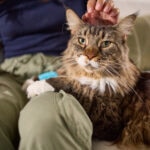Hot Spots on Cats: Treatment and Home Remedies

Photo by primeimages/Getty
If you’ve ever noticed a raw, red, hairless sore suddenly pop up on your cat’s skin, it could be a hot spot. Cats get hot spots in response to allergic reactions. They are itchy, painful and need prompt veterinary attention.
Key Takeaways
- Hot spots are superficial skin infections caused by cats scratching, licking, or chewing themselves.
- Hot spots on cats are typically a symptom of underlying issues like fleas, allergies, stress, or pain.
- Treatment my include clipping the fur to clean the area and using topical or oral medications prescribed by a vet.
- Prevention involves managing fleas, allergies, stress, and keeping up with regular veterinary exams.
What Are Hot Spots on Cats?
Also known as acute moist dermatitis and pyotraumatic dermatitis, hot spots on cats are superficial skin infections that occur suddenly. A hot spot happens when a cat licks, chews, scratches or bites their skin enough to make it raw. A cat’s skin normally has certain types of bacteria and yeast living on it with no problems. However, when the skin is irritated, bacteria overgrowth can create dermatitis, a full-blown skin infection.
While any cat can get a hot spot, certain types may be more prone to them:
- Long-haired and thick-coated cats may be more prone because of matting that can trap debris and saliva under the fur.
- Older or disabled cats who can’t groom themselves well may be at increased risk, too.
- Outdoor cats who come into contact with parasites are also at increased risk for hot spots.
Hot spots occur year round but are more common during warm, humid summer months, when biting or sucking parasites and allergies are active. Hot spots can happen anywhere on the body, but they tend to be seen on a cat’s:
- Face/chin
- Neck
- Belly
- Lateral thigh
- Around the base of the tail
Hot spots are common in dogs but rare in cats.
What Do Hot Spots on Cats Look Like?
Hot spots have a very distinct look. They appear suddenly, are very itchy and have the following qualities:
- Get bigger very quickly
- Well-defined edges
- Redness
- Hair loss
- Weepy, moist and raw skin
- Painful
Hot spots typically show up as one single lesion, but there can also be multiple hot spots. Hot spots can also be hidden by matted hair.
What Causes Hot Spots on Cats?
Hot spots occur in the following sequence:
- Something makes the cat’s skin itchy or irritated.
- The cat bites, chews or scratches themselves raw, creating a bald, red, oozing hot spot.
- Staphylococcus (bacteria usually considered normal flora for cat skin) overgrows and causes a localized skin infection on the abraded, damaged skin.
- The cat licks the hot spot more, creating a vicious cycle.
Hot spots on cats aren’t primary skin diseases; they are almost always an indicator of an underlying skin disorder that is making the cat itchy. Causes of hot spots in cats can include:
- External parasites, including fleas, mites and ticks
- Other stinging or biting insects, such as mosquitoes, bees or ants
- Allergies. The most common skin allergies in cats are flea allergy, food allergy and atopic dermatitis (seasonal allergies)
- Contact dermatitis from hypersensitivity to a detergent or cleaning product
- Overgrooming from stress, anxiety or compulsive disorders
- Overgrooming from joint pain or anal gland pain
- Overgrooming a wound
- Ear infections and/or ear mites
Hot Spots on Cats Treatment
Treating cat hot spots involves several steps:
- Removing the hair around the hot spot
- Cleansing and drying the infected skin
- Testing (if necessary) to diagnose the cause
- Applying a topical medication
- Fitting the cat with a recovery cone or shirt to prevent them from licking or scratching the hot spot
How to Prevent Hot Spots on Cats
The best way to prevent hot spots on cats is to avoid exposing them to things that cause hot spots. This can include:
- Consistently using flea and tick prevention on your cat to prevent flea allergies.
- Working with your local veterinarian or a board-certified veterinary dermatologist to diagnose and treat other allergies.
- If your cat has seasonal allergies (atopic dermatitis), options for treatment include avoiding the allergen, immunotherapy, antihistamines or other prescription-strength allergy medication.
- If your cat has food allergies, work with your veterinarian to conduct a food-elimination trial and/or feed your cat a therapeutic, hypoallergenic food.
- Have ear mites and/or ear infections treated promptly.
- Provide environmental enrichment and appropriate resources to your cat to reduce stress.
- Talk to your veterinarian about pain control for joint disorders that might cause over-grooming.
- Consider giving your cat a high-quality fish oil supplement, which has been shown to benefit skin health.
- Take your cat to the vet annually to catch any problems early.
Recommended Product
FAQs About Hot Spots on Cats
Will hot spots go away on their own?
Are cat hot spots contagious?




